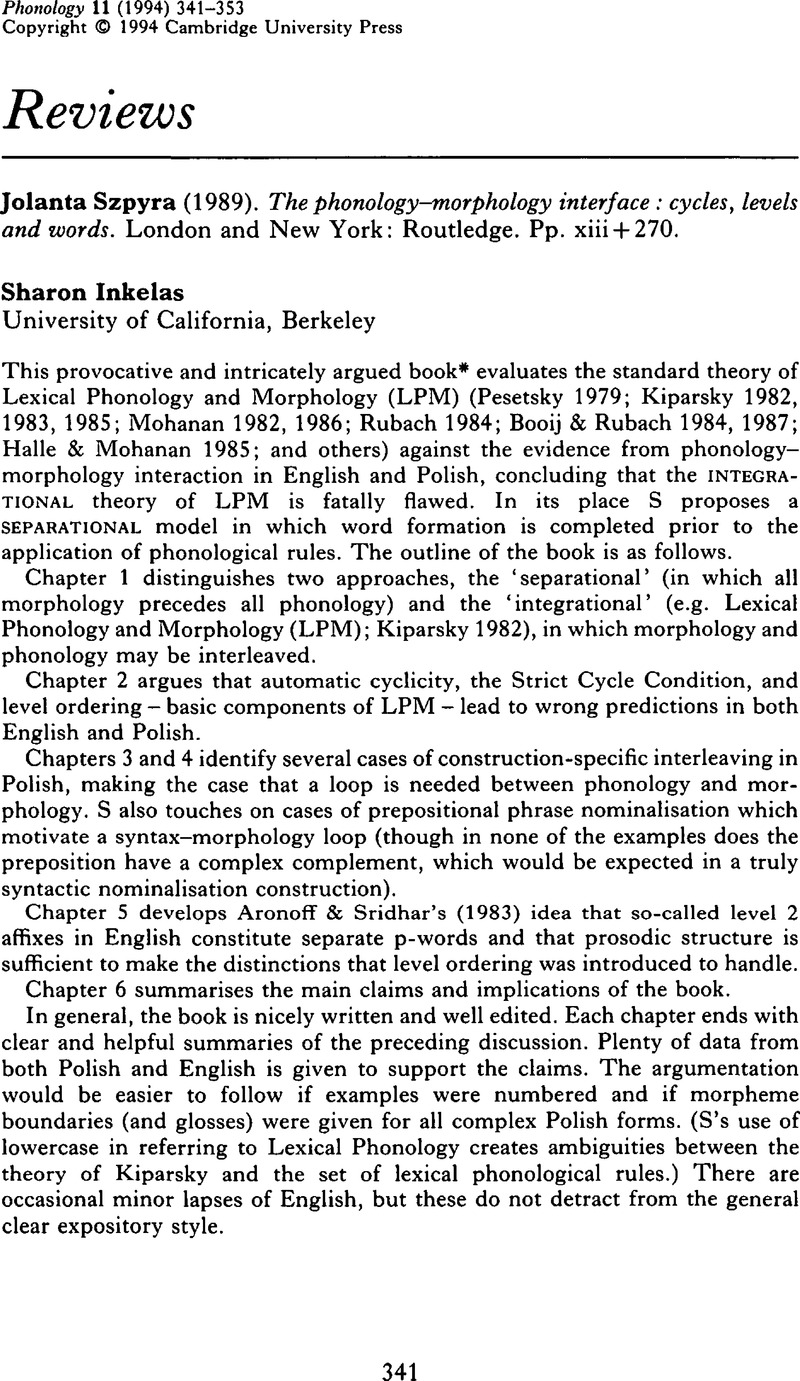No CrossRef data available.
Article contents
Jolanta Szpyra (1989). The phonology–morphology interface: cycles, levels and words. London and New York: Routledge. Pp. xiii + 270.
Published online by Cambridge University Press: 20 October 2008
Abstract
An abstract is not available for this content so a preview has been provided. Please use the Get access link above for information on how to access this content.

- Type
- Review
- Information
- Copyright
- Copyright © Cambridge University Press 1994
References
Aronoff, M. & Sridhar, S. N. (1983). Morphological levels in English and Kannada. In Chukerman, A., Marks, M. & Richardson, J. (eds.) Papers from the parasession on the interplay of phonology, morphology and syntax. Chicago: Chicago Linguistic Society. 3–16.Google Scholar
Booij, G. (1985). Coordination reduction in complex words. In van der Hulst, H. & Smith, N. (eds.) Advances in non-linear phonology. Dordrecht: Foris. 143–160.Google Scholar
Booij, G. & Rubach, J. (1984). Morphological and prosodic domains in Lexical Phonology. Phonology Yearbook 1. 1–27.CrossRefGoogle Scholar
Booij, G. & Rubach, J. (1987). Postcyclic versus postlexical rules in Lexical Phonology. LI 18. 1–44.Google Scholar
Booij, G. & Lieber, R. (1993). On the simultaneity of morphological and prosodic structure. In Hargus & Kaisse (1993). 23–44.Google Scholar
Buckley, E. (1992). Theoretical aspects of Kashaya phonology and morphology. Stanford: CSLI.Google Scholar
Christdas, P. (1988). The phonology and morphology of Tamil. PhD dissertation, Cornell University.Google Scholar
Chung, S. (1983). Transderivational relationships in Chamorro phonology. Lg 59. 35–66.Google Scholar
Cole, J. & Coleman, J. (1993). Cyclic phonology with context-free grammars. Technical report UIUC-BI-CS-92-06, University of Illinois.Google Scholar
Halle, M. & Kenstowicz, M. (1991). The Free Element Condition and cyclic versus noncyclic stress. LI 22. 457–501.Google Scholar
Halle, M. & Mohanan, K. P. (1985). Segmental phonology of Modern English. LI 16. 57–116.Google Scholar
Hargus, S. (1985). The lexical phonology of Sekani. PhD dissertation, UCLA. Published 1988, New York: Garland.Google Scholar
Hargus, S. & Kaisse, E. (eds.) (1993). Studies in Lexical Phonology. San Diego: Academic Press.Google Scholar
Hayes, B. (1989) [1984]. The prosodic hierarchy in meter. In Kiparsky, P. & Youmans, G. (eds.) Rhythm and meter. Orlando: Academic Press. 253–306.Google Scholar
Hyman, L. (1991). Cyclic phonology and morphology in Cibemba. To appear in Cole, J. & Kisseberth, C. (eds.) New frontiers in phonology. Stanford: CSLI.Google Scholar
Inkelas, S. (1989). Prosodic constituency in the lexicon. PhD dissertation, Stanford University. Published 1990, New York: Garland.Google Scholar
Inkelas, S. & Orgun, O. (1993). Level economy, derived environment effects and the treatment of exceptions. In Wiese, R. (ed.) Proceedings of a Workshop on Recent Developments in Lexical Phonology. Düsseldorf: Heinrich-Heine Universität.Google Scholar
Kiparsky, P. (1982). Lexical morphology and phonology. In Yang, I.-S. (ed.) Linguistics in the morning calm. Seoul: Hanshin. 3–91.Google Scholar
Kiparsky, P. (1983). Word formation in the lexicon. In Ingemann, F. (ed.) Proceedings of the 1982 Mid-America Linguistics Conference. Lawrence: University of Kansas. 3–29.Google Scholar
Kiparsky, P. (1985). Some consequence of Lexical Phonology. Phonology Yearbook 2. 83–138.CrossRefGoogle Scholar
Lieber, R. (1980). On the organization of the lexicon. PhD dissertation, MIT. Distributed by Indiana University Linguistics Club.Google Scholar
Mascaró, J. (1976). Catalan phonology and the phonological cycle. PhD dissertation, MIT. Distributed by Indiana University Linguistics Club.Google Scholar
Mohanan, K. P. (1982). Lexical Phonology. PhD dissertation, MIT. Distributed by Indiana University Linguistics Club.Google Scholar
Prince, A. & Smolensky, P. (1993). Optimality theory: constraint interaction in generative grammar. Ms, Rutgers University & University of Colorado, Boulder.Google Scholar
Rubach, J. (1984). Cyclic and Lexical Phonology: the structure of Polish. Dordrecht: Foris.CrossRefGoogle Scholar
Szpyra, J. (1992). Ghost segments in nonlinear phonology: Polish yers. Lg 60. 277–312.Google Scholar




